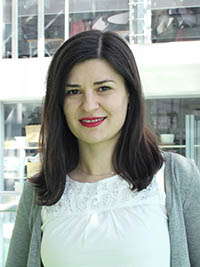Malvina Kolici

XXXIII Cycle - (A.A. 2017-2018)
IDAUP
Home Institution: Polis University Tirana
With Research Contract
Curriculum: Architecture (ICAR14)
Research Topic: Accommodation Tourism Structures
Tutor DA-UNIFE: Prof. Luca Emanueli
Tutor Polis University: Prof. Vera Bushati
Nationality: Albanian
Email: klcmvn@unife.it
Profile
Biography
Born in Kukes, Albania in 1987, Malvina is a graduated architect with interest in theoretical research.
In 2006 she undertakes her study at Faculty of Architecture and Design of POLIS University, where she graduated 6 years later with the degree: Master of Science in Architecture and Urban Design. After the conclusion of her studies, she concentrated her research activities, in a professional Master Program dedicated to Housing Land Development. These studies, oriented by HIS – Erasmus in Rotterdam, developed her interest in urban context and architectural impact in the life of cities. Meantime, architectural design was part of her professional career through interior design projects in Tirana as a freelance architect.
Current engagement of Malvina, is being part of the staff of POLIS University by serving as an assistant lecturer in History of Architecture course and by enrolling in November 2017, in the Ph.D. course of the University of Ferrara and Polis University, where she currently is conducting a research dedicated to tourism and accommodation structures. Recently, she has been engaged in a project of Design and Promotion of the Cultural Landscape at University of Molise.
Research skills
Architecture Design | Urban Design | History of Architecture | Urban Management | Housing Policies
Scientific activities
ORCID ID:
0000-0002-2190-3757
IRIS UNIFE ID:
rp51972
Doctoral research
Accommodation Tourism Structures. The Case of Post-Communist Albania
The aim of this study is to investigate the accommodation tourism structures in post-communist Albania. This research is intended to achieve an understanding of the development of these touristic structures in terms of architecture, space and qualities of facilities. Modern era has created another concept for tourism and architecture, by considering it “architecture tourism”. During the last decades there have been approaches by several cities to not just use architecture in favour of tourism, but actually to build architecture so that it can generate tourism. The case of Bilbao (1997), China, Dubai etc., represents clear examples where architecture itself has become such an attraction, as it has become the landmark and point of interest for visiting. Architecture plays a critical role in almost every area of tourism, providing infrastructure to enable tourists to reach the destination and once in place, accommodation to host them, while also offering venues for leisure activities. Thus, by providing space and allowing movement as some of the most basic prerequisites for tourism, it can be argued that tourism is barely conceivable without architecture (Specht, 2014). It is just the place to think that it’s architecture obligation, to offer quality of space, functional and well-oriented space, as well as caring for security or hygiene factors to make to guests a very positive experience. Therefore, by encroaching in space, architecture and designers have the ability of either improving or destroying it, thus depriving space, as a primary provider of the tourism offering, of its original value. In communist Albania, tourism was represented by three main accommodation structures: Holiday Camps (dedicated to workers, state administration or specific groups of population), Hotel “Tourism” (an accommodation structure within the city which generally expected foreigners and administrative or diplomatic staff), Government Villas (mostly designed for the government families). With the fall of communism in 1990, just like every aspect of the society, the touristic accommodation structures were developed more freely. Main Objective: Tourism Industry is a sector where is invested enormous amount of money, to meet the construction and design needs; although design concepts, reasonability, sustainability and environment are hardly taken into account. The first observation towards the tourism in Albania, reinforces the above mentioned statement that’s why in this research, the main aim is about understanding the variation of touristic accommodation structures and approaching a sustainable model of development.
Keywords
Hotel Design | Typology | Form | Local influences | Sustainable Development

